The reigning doyenne of traditional Spanish dance in Toronto, Esmeralda Enrique, modestly introduced this generous offering of ideas to a gathering of some thirty professionals, students, aficionados and casual followers by stressing the importance of imparting deeper knowledge and greater context to the art of flamenco in Canada. Enrique arrived here thirty-two years ago from San Antonio, Texas. She has since established an academy and company that has attracted top-flight international teachers and performers, established professional careers for her former students and cultivated a devoted local audience.
Enrique is a dancer. However, flamenco is a tripartite art form that relies equally on dance, voice and instrumentation as integrated elements. This – the second such symposium that Enrique has organized – aimed to restore (at least in awareness) a balance that has been missing in Canadian flamenco. Canadian students of flamenco dance are primarily women. Yet the traditional Spanish society that adjudicates its native flamenco culture remains intractably male dominated. Therefore, the symposium’s focus on the legacy of female artists put into perspective gender constraints that have shaped the modern growth of the art. As well, the popularity of flamenco dance in Canada has overshadowed the slower accumulation of capable flamenco guitarists and, more particularly, singers. Enrique noted in her introduction that this is beginning to change, with an influx of Hispanic immigration that brings with it an essential Spanish language demographic and a firsthand acquaintance with flamenco in South and Central America (where it flourished during the era of artistic exile precipitated by the Spanish Civil War and the long dictatorship of Francisco Franco).
Enrique quickly yielded the podium to two esteemed flamencologists, Estela Zatania of Jerez de la Frontera and Pepa Sánchez Garrido of Seville, both cities in the Spanish Andalusian heartland of flamenco territory. Zatania’s opening session provided an overview of the life of Carmen Amaya, considered the greatest dancer of modern flamenco. Amaya (1917–1963) had a tragically brief life. Born in a gitano (Spanish gypsy) slum in Barcelona, she rose from childhood prodigy to become a leading lady of flamenco film. Eventually, she became an expatriate star in the Americas, appearing at Carnegie Hall and the Hollywood Bowl, before finally returning to Spain in the final years of her life. Singlehandedly, Amaya transformed the popular, worldwide image of flamenco from a folkloric (and, for women, maidenly and demure) art to its carnal embodiment of tempest, volatility and danger. However, even in her marquee years, Amaya yielded crucial business affairs to male family members, who, likely protecting their own pecuniary interests, prevented her from marrying her beloved artistic and emotional counterpart, the great gypsy guitarist Sabicas. So, the tragedy of Amaya’s life was compounded, with the normative subjugation of women added to the poverty and social marginalization of her gypsy class.
A presentation by Pepa Sánchez followed with consecutive sessions devoted to flamenco singing (cante). The first was historical, tracing the ancient origins of Andalusian folk music, which combined elements of musical traditions dating as far back as the Roman Empire. In the fifteenth century during the Spanish Inquisition, gitanos Jews, and Moors claimed remote enclaves in Andalusia as a safe homeland. Thus began long centuries of assimilation that would eventually converge in dance academies and cafés cantantes during the mid-nineteenth and early twentieth centuries. Sánchez outlined six primary forms of cante, describing in each its distinguishing structural relationship of verse (terzia), count (compás), as well as each one’s social roles with respect to history, content and setting. Following this musicological introduction, Sánchez led a workshop that emphasized the primary role of oral transmission in the fundamental integration of song to music and dance. (For instance, Carmen Amaya was a capable guitarist and singer, a versatility that is uncommon in today’s age of artistic specialization.) Having established the crucial role of oral transmission, Sánchez then examined the factors that led to the formal variation and evolution of cante, such as the wild card of memory, individual vocal and musical faculties, the singer’s personality, the performance context and lyrical demands; i.e., flamenco songs are narrative, frequently topical and new words may require new stylizations.
On Day Two, Zatania again headed up the morning session with a presentation on festeros, a more private, insular and traditional social form for flamenco performance that has its own styles of song and dance, which are more lighthearted and less theatrical. The setting of festeros is a fiesta. It is led by what is essentially a master of ceremonies or cante jondo, a figure who is a dancer that sings, or a singer that dances. Its core form is the bulería, which has elastic, drone-like instrumentation that can adjust to the lead of the emcee. A cante bulería is typified by tragicomic verses about the philosophical acceptance of life, jokes about poverty and biting irony. Festeros is considered to be a dying art. After the session, Toronto flamenco mistress Carmen Romero, once a childhood student of Esmeralda Enrique, led the symposium participants through a series of dance exercises in bulería, which, owing to its origins outside of theatre, was unfamiliar to even many of the more experienced attendees.
The final lecture session, led by Sánchez, focused on the story of female singers of flamenco, or cantaoras, which has been a story of particular sadness and struggle owing to the Andalusian social subordination of women and its male-dominant code, but also to the persistence of demeaning female erotic and exotic stereotypes (for example, the romance of the prostitute). Sánchez introduced several outstanding historical cantaoras: La Trini, La Sernata, La Niña de los Peines, La Repompa de Malaga and La Perla de Cádiz. They left a legacy of strong, sincere, perseverant female voices, the future of cante for both women and men.
The Art of Flamenco Symposium concluded with an in-the-round conversation between all participants, which, true-to-form, brought out personal stories, some of which had surprising intersections. For instance, Estela Zatania had seen Pepa Sánchez’s father, a distinguished flamenco singer, perform at the New York World’s Fair in 1964.
As flamenco continues to build an audience and artistic base in Canada, opportunities presented by this kind of labour of dedication by Esmeralda Enrique will be crucial. She is far from the only contributor to this end. Consider also the Toronto International Flamenco Festival that took place October 13 to 20, which featured dance performances and workshops by international star La Lupi and others. That such a small event as The Art of Flamenco Symposium could register participants from across Canada indicates that it identified where the discourse must head to fulfill broader enthusiasm for the art.
The Art of Flamenco Symposium was presented by Esmeralda Enrique Spanish Dance Company on October 5 and 6, 2013 at Beit Zatoun House in Toronto.
Tagged: Flamenco, On the Ground, Algeria , All




